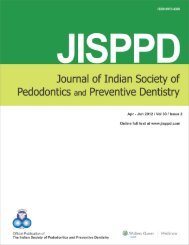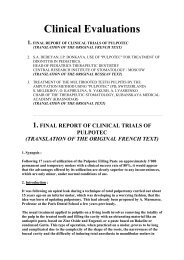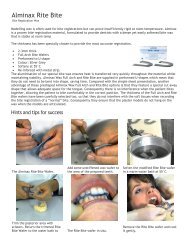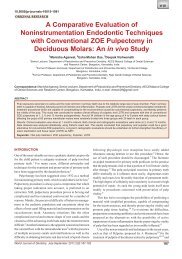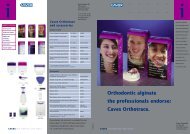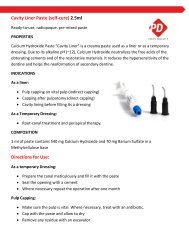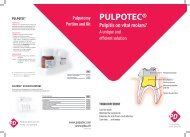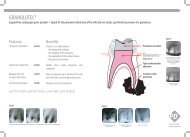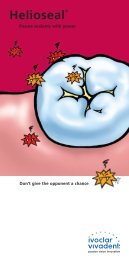REFLECT
View File - universaldental.com.pk
View File - universaldental.com.pk
- No tags were found...
Create successful ePaper yourself
Turn your PDF publications into a flip-book with our unique Google optimized e-Paper software.
06<br />
Fig 8 Finishing with Astropol HP (pink) silicone rubber cups<br />
Fig 9 Close-up view of the restored maxillary incisors showing<br />
the life-like anatomy and surface texture<br />
light-cured for 10 seconds each from the labial, palatal<br />
and proximal aspect using the bluephase C8 LED light in<br />
the high power mode (HIP mode).<br />
After having completed the two central incisors, the<br />
remaining lateral incisors and canines were restored using<br />
the same technique. The same approach was chosen for<br />
the restoration of the mandibular anterior teeth.<br />
As in this case the gingival health was comparatively poor<br />
initially (because of the presence of caries and heavy<br />
plaque accumulation), the final finishing and polishing<br />
steps to establish the secondary anatomy were post poned<br />
until the next appointment scheduled for the following<br />
week. By deferring this step, clinicians are given the opportunity<br />
to re-check the restoration margins and modify<br />
them if needed. Dental photography is an essential tool<br />
for the clinician to judge the final outcome and achieve<br />
highly aesthetic restorative results! In this case, a few deficiencies<br />
were noticed on the photographs that were taken<br />
after shaping the primary anatomy during the first session.<br />
Based on the patient’s requirements a few modifications<br />
were made by adding more composite on the mesial side<br />
of right central incisor and in other areas.<br />
Finishing and Polishing<br />
After the modifications had been carried out, the secon d -<br />
ary anatomy (marginal ridges, developmental grooves,<br />
lobes, the cingulum, etc.) was accentuated with 12 fluted<br />
carbide and diamond finishing burs. The proximal, incisal<br />
and facial surfaces were contoured with aluminum oxide<br />
discs and finishing strips. For finishing, finishing burs, diamonds<br />
and Astropol ® rubber wheels and points were used.<br />
The Astropol finishing and polishing system consists of rubber<br />
points, cups and discs impregnated with either silicon<br />
dioxide or silicon dioxide and fine diamond particles.<br />
In a first step, Astropol F (grey) instruments were used in<br />
a slow-speed handpiece and with water cooling to re -<br />
move excess and achieve a smooth surface. Then the<br />
Astropol P polishers (green) were employed in the same<br />
way. They impart a very delicate surface finish to composite<br />
restorations and can be used to establish the secondary<br />
anatomy and surface texture. The third step involved the<br />
use of the micro-fine Astropol HP (pink) high gloss polish -<br />
ers (Fig 8). Polishing was done without exerting any<br />
pressure. Astrobrush was used at slow speed and without<br />
any pressure to impart the restorations with a high luster<br />
while maintaining the surface texture and anatomy previously<br />
created (Fig 9). This procedure was repeated after<br />
having modified the restoration according to the requirements<br />
of the patient.<br />
Conclusion<br />
When fabricated properly, composite restorations can be<br />
long lasting and beautiful, appearing as real as nature<br />
intended. State-of-the-art composite materials such as<br />
Tetric N-Ceram with their variety of shades, mechanical<br />
strength and good polishability allow clinicians to close<br />
gaps, transform spaces and enhance colours without<br />
having to remove a large amount of tooth structure. In<br />
the complex restorative case presented, which involved<br />
cervical and proximal caries, poor gingival health and<br />
poor overall aesthetics, a methodological approach was<br />
used. An incremental technique with composite resin was<br />
applied to create highly aesthetic restorations which<br />
mimic nature and blend in seamlessly with the surround -<br />
ing dentition. The young patient was very happy with the<br />
final outcome!<br />
He received Cervitec Gel and tips and tricks on how to<br />
maintain the current oral hygiene status to keep the final<br />
restorations in good condition for as long as possible. ❑<br />
Contact address:<br />
Dr Arun Rajpara<br />
Soham Dental<br />
Center for Cosmetic & Advanced Dentistry<br />
Opp. Lal School, Halar Road,<br />
Valsad – 396001/India<br />
arunrajpara@gmail.com



